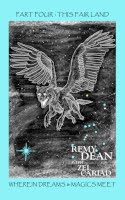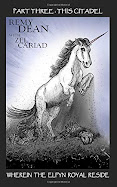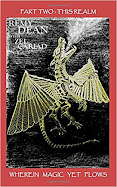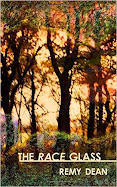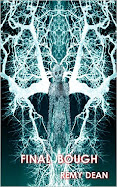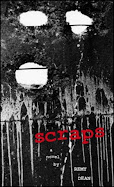Call it ‘Technogothic’, ‘Cybergoth’ or ‘Futuregoth’, there is a strong emergent genre making its mark throughout contemporary cultures and media, laced with a strong sense of nostalgia yet tempered with an astute vision of the future and at the same time making valid comments on our present… Sometime in the 1990s (the recent past) I identified several recurring themes within many of my favourite films, TV shows, novels, songs, etc... I intended to 'pin-down' these elements in a new fanzine to be called 'Futuregoth'. As it turned out, this idea distilled into a feature for the literary 'zine, 'Scrawl'.
Now, with the new-look Doctor Who back on Saturday evenings, I was reminded about this take on an emergent genre that already seems to have become a mainstream part of the British psyche... and quite fittingly, as the first 'Gothick scene' originated with Romanticism... a British-based art and literary movement that has had a big international influence to this day. So I revisited the article and present it here, slightly 'tweaked' and revised, for the (post-)modern world.

‘Gothic’ is a word that can evoke a strong reaction, either positive or negative, depending on which set of preconceptions you may hold... One thing that is clear, like it or not, the Gothic genre has been enjoying a renaissance.
Goths were a barbaric Germanic tribe who spread across Europe, establishing kingdoms through France, Spain and Italy during the third, fourth and fifth centuries CE. The term ‘gothic’ was coined by architects of the Renaissance period to describe building styles that they considered to be barbaric, uncouth or out-moded, choosing the classicism of ancient Greece and Rome as their paragon of good taste. The buildings branded gothic by Renaissance sensibilities were the great mediaeval cathedrals and abbeys which tended to be monolithic, with highly decorated exteriors and dark foreboding interiors…
The first Gothic Revival sprang forth in the Victorian era with architects like Pugin and Giles Scott at the vanguard, backed-up by the likes of Walpole and Ruskin. Arts and architecture from this early nineteenth century revival are often referred to as ‘Gothick’ - with a ‘k’ and coincided with a new fashion in literature. The imaginative works of Shelley, Stoker, Byron, Conan Doyle and Poe became hugely popular and spawned a trend for stories containing elements of the supernatural, linking the Romantic sensibilities to the gothic genre. Science, exploration and discovery also took leaps and bounds – the antiquities of ancient Egypt, the cultures of the far east – feeding the imaginations of writers and readers alike. Hence the genre of the Gothic(k) was created.
The Gothic genre took on the darkness and intricacies of the architecture, the macabre shadows of the human imagination and the inventiveness of science along with all the hopes and fears it presents.
The term became widely used during the 1980s when it was used by the media to label certain elements within the prevalent ‘New Romantic’ pop culture, particularly the fusion of punk-rock and electro-beat along with its accompanying fashions of the ‘Romantic Poet look’ – originally made popular a century earlier by the likes of Byron, who it is believed inspired the popular image of the vampire – dark hair, pale skin, moody manner, and nineteenth century garb…
The earliest, transmedia manifestation of Futuregoth was long before it ever had a jargon tag to identify it as a genre, yet clearly exhibits all the elements and criteria to qualify - Fritz Lang’s (recently restored) film adaptation of Metropolis is the perfect example…
In 1926, film, as an artform in itself, was new and represented a marriage between technology and art. An alchemical process – involving metal oxides, light and incandescent arcs – the ‘magic lantern’ could be used to ‘realise’ the imagination into a visible, sharable commonality. Since the dawn of human language, society has sought ways to share its dreams. Film is merely the most recent and effective method that has, generally, superseded all other forms of dream-sharing employed by all tribal communities, particularly throughout western culture.
As David Annan observed in his book, Cinema Of Mystery And Fantasy, “Metropolis is the bridge between ancient myth and the machine world of mass man”. Lang’s masterpiece was based upon the novel by Thea Von Harbou, though he drew heavily from Wagnerian themes and his own fascination with folklore and myth – which was to reveal itself throughout the German persona over the following decades. Indeed, Metropolis is a chillingly prophetic reflection of the national social trends of its day, all be it viewed through the artistic lens of speculative science fiction.
The central plot of the film deals with a split in society. There is an underground city of the workers, who maintain the giant machines and feed the furnaces that drive the overground city of the privileged citizens. It is a cautionary tale of mass industrialisation and automation leading to the enslavement of humanity, echoing the sentiments expressed by British poet, William Blake, who had warned at the dawn of the industrial revolution that reliance on mechanisation would lead to the workers and traditional artisans becoming thought of merely as a resource that serves the machines. In effect, reducing the craftspeople and workers to the same level as machine components within “Dark Satanic Mills”.
In the extreme scenario of Metropolis there is nothing but the city, above and below, both equally hellish in their own way. The workers enslaved by machinery, the citizens trapped by empty decadent lifestyles. The result is inevitable revolution which finally re-unites society.
The magician-alchemist, Rotwang (below, left, with his robot creation), is the catalyst for the events that bring about profound change. He represents the past, the city’s forgotten heritage - the craft of magick denied by modern thought. His house is a dark mediaeval building still standing in the heart of the city, dwarfed by the sky-scraping erections of girders and glass. The events that lead to the machines stopping and the underground city being flooded begin in the dark interior of the ‘mad professor’s’ house and, fittingly, reach final culmination on the roof of the great cathedral, which is the only other gothick structure still standing.

The film employs rich gothic imagery throughout… The entrance to the chambers of the great machines resembles a giant Molochian effigy (above, right), devouring its workers at the start of their shift and spitting them out when they are spent. The image of Death is glimpsed fleetingly, playing his dance on a hollow human thigh bone. Ancient symbols empower Rotwang’s environment and the famous android he constructs and animates using a blend of technology and magick echoes many myths, from the Golem to Frankenstein’s monster.
Metropolis also features in my book Evolution of Western Art
A very similar scenario was also examined in the H G Wells cautionary classic, The Time Machine, which presented a future which, on the surface appears utopian, but underneath is distinctly dystopian. The story moves from the Victorian era to a time in the far future where a society resembling that of Metropolis has evolved to an extreme conclusion without the beneficial interruption of revolution. The privileged surface dwellers have become oblivious hedonists who do not question the fact that, periodically, they are culled by the Morlocks - subterranean cannibalistic mutants who have evolved from the ancient working class consigned to maintain and operate great machines for untold centuries.
Wells is generally accepted as the ‘founding father’ of science fiction and certainly planted many seeds in the newly broken ground. He bravely merged religious themes with fantasy in stories like The Apple and A Dream Of Armageddon and went on to be the first writer to tackle the potential horror of contact with a hostile alien foe in The War Of The Worlds. So we have two major themes, time travel and alien invasion, being introduced to creative literature by a single author!
The recurring theme of a society that appears desirable, being built upon the enslavement of a section of humanity was taken to the extreme in the blockbuster, The Matrix, where all humans are the slaves, or rather livestock, of machines and the human society they believe in is merely a fiction implanted by the machines in order to pacify the crop. The masses are happy in their oblivion and even when a few are ‘unplugged’ from the machine-induced fantasy, some choose to return…
The Matrix is a highly intelligent and multi-levelled metaphor. It takes in the concept of virtual reality, examines the worth of human perception – what is real and what is fantasy, and how does one tell? The film considers the different levels of consciousness we all (should) experience – from sleep and dreams, through ‘normal waking life’, to the higher imagination and understanding…

The humans who get ‘unplugged’ (such as Neo, anagram of One, above) wake up into a new mediaevalism, literally a second Dark Ages that, though in the future, echoes the barbaric past. Understanding how to transcend the fabricated reality of the machines’ matrix is the new magick, the machines themselves our new demons.
The whole feel of the film is reminiscent of the 1980s Gothic New Wave – dark environments, pale people, with dark clothes who look ‘kinda cool’, along with a prominent and pumping punk-metal-electro sound track. Like Lang’s Metropolis, the film itself utilizes the breakthrough science and technology of its time – some of which was developed specifically by the film-makers – particularly the opportunities presented by the current digital revolution.
The first film to stimulate the use of terms such as ‘technogothic’ in the mass media was 1997’s Event Horizon, written by Philip Eisner and directed by Paul Anderson. This movie comes close to being the definitive Futuregoth vehicle, and this is no accident. Production designer, Joseph Bennett, intentionally designed sets for the interiors of the Event Horizon space ship to resemble the vaulted catacombs of the Notre Dame Cathedral, with thick pillars that flare upwards to meet with the curve of walls. He reasoned that as the pillars of stone were constructed to withstand the vast stress of supporting such immense weight, so the structure of the space ship would have to withstand the stresses of deep space and the huge strain of passing through dimensional folds. The resulting gothic ‘feel’ pervades the film, with the emergency lighting creating a moody environment swathed with evocative shadows.

It is not only the look of Event Horizon that makes it Futuregoth, it is the whole story and its subtext. The plot concerns a rescue/salvage mission sent to investigate the reappearance of the experimental space vessel, Event Horizon. The Event Horizon is a new generation of star ship fitted with a revolutionary drive (above) that harnesses forces similar to those of a black hole in order to fold space, effectively making it possible to travel from one point to another as if faster than light - a theory based on a proven phenomenon known as ‘quantum tunnelling’. When the drive was first used, the ship disappeared and was thought destroyed. What really happened to it is a mystery - it went somewhere and it came back… and as the film plot progresses, it becomes apparent that, instead of opening a tunnel from one point in space to another, it has been to another dimension, the place where ‘demons’ come from…
The story begins with foreshadowing by prophetic dreams and visions visited upon the central characters involving ‘dead’ people, either returning from the ‘afterlife’ or revisiting from the past life of the character. The character portrayed by Sam Neil sees his dead wife in scenes that echo Andrei Tarkovsky’s 1972 classic Solaris and tackle ideas of romance outliving death, or granting the strength to face death, thereby affirming life (similar to the romantic thread that runs through Bram Stoker’s Dracula).
The technological, ‘cold-but-safe’, environment is inexorably ripped apart and the cutting-edge science opens a doorway to a future dimension which has the potential to be claimed by good or evil, to affirm or deny life. The boundaries between science and religion are smudged. Parallels arise between the theory of quantum metaphysics and the ancient magickal philosophy of astral spheres. The overall plot structure and narrative drive follows a Dante-esque ‘descent into the inferno’ pattern.
On TV we have repeatedly revisited ‘Futuregoth’ themes and elements with the Doctor in the longest running and most inventive of all SF television series, Doctor Who. Most notably under Philip Hinchcliffe’s tenure as Producer in the 1970s, Doctor Who has always enjoyed mixing the past and future and bringing them into the present, liberally borrowing from classic gothick fiction and throwing it in with inventive and original SF twists. Under Hinchcliffe, the key episodes that become almost definitive of ‘Futuregoth’ are The Pyramids Of Mars, The Brain Of Morbius, The Masque Of Mandragora, the Robots Of Death, The Talons Of Weng-Chiang, Image Of the Fendahl, The Stones Of Blood… all with Tom Baker in the title role. Only with the recent Who revival under Russell T Davies, and now Stephen Moffat, have we stories as consistently inventive and openly revelling in gothick-SF fusion: check out The Empty Child/The Doctor Dances, The Girl In The Fireplace, The Impossible Planet/Satan Pit, Blink, Silence In The Library/Forest Of the Dead, The Beast Below…
Oh yes! I am sorely tempted to go into an extensive list of recent ventures into the realm of ‘Futuregoth’ in the wider media of cinema and literature. Perhaps I will. But for now I think you can have fun doing that for yourself. Compare lists with your friends as some sort of drinking game…
So, in conclusion, what can be said to be the elements of Futuregoth? Certainly Romanticism and heroism feature at the forefront, probably pitted against, or dealing with, archaetypes from myth and folklore. Past and future should be seen to influence and inform the present - either our own ‘now’ or the ‘present’ within the virtual reality of the tale… which may well be a possible future, or perhaps another past, or even an alternative present. There should be an alternative/separate/virtual reality or otherworldly influence, perhaps an analogy for the dreamworld or the different levels within our own consciousness. There should be strong SF ingredients, technology revealing something that is transcendent… and no matter the odds, the human spirit should be triumphant – or at least, a way in which it could be, is proposed. The whole atmosphere of any work of Futuregoth should be mythic, dark, spooky… y’know, kinda ‘gothic’.


.jpg)

